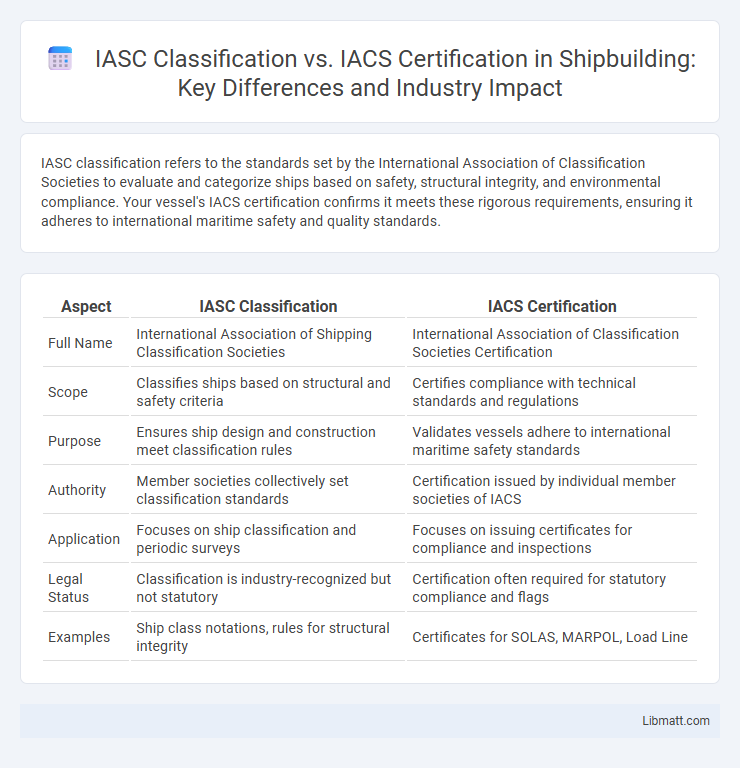IASC classification refers to the standards set by the International Association of Classification Societies to evaluate and categorize ships based on safety, structural integrity, and environmental compliance. Your vessel's IACS certification confirms it meets these rigorous requirements, ensuring it adheres to international maritime safety and quality standards.
Table of Comparison
| Aspect | IASC Classification | IACS Certification |
|---|---|---|
| Full Name | International Association of Shipping Classification Societies | International Association of Classification Societies Certification |
| Scope | Classifies ships based on structural and safety criteria | Certifies compliance with technical standards and regulations |
| Purpose | Ensures ship design and construction meet classification rules | Validates vessels adhere to international maritime safety standards |
| Authority | Member societies collectively set classification standards | Certification issued by individual member societies of IACS |
| Application | Focuses on ship classification and periodic surveys | Focuses on issuing certificates for compliance and inspections |
| Legal Status | Classification is industry-recognized but not statutory | Certification often required for statutory compliance and flags |
| Examples | Ship class notations, rules for structural integrity | Certificates for SOLAS, MARPOL, Load Line |
Overview of IASC Classification
IASC Classification provides a framework for evaluating the safety and environmental standards of yachts, ensuring compliance with international maritime regulations. This classification system focuses on structural integrity, stability, machinery, and electrical installations to guarantee the vessel's seaworthiness. Your yacht's adherence to IASC Classification standards enhances its value and assures operational safety during voyages.
Introduction to IACS Certification
IACS Certification refers to the formal approval issued by recognized organizations within the International Association of Classification Societies (IACS), confirming that a vessel or marine structure complies with specific technical standards and safety regulations. This certification process involves rigorous inspections and assessments based on standardized rules developed by member societies to ensure maritime safety and environmental protection. IASC classification, often confused with IACS certification, generally pertains to the categorization methods used by individual classification societies but lacks the formalized, unified certification status that IACS provides.
Historical Background: IASC and IACS
The International Association of Classification Societies (IACS) was established in 1968 to unify and standardize ship classification rules globally, enhancing maritime safety and environmental protection. The International Association of Shipping Classification Societies (IASC) originally served as a cooperative framework among various classification entities but evolved as IACS emerged as the leading authority in setting industry standards. Understanding the distinction between IASC classification and IACS certification helps clarify the historical development of classification societies and their pivotal role in your ship's compliance and safety validation.
Key Differences: Classification vs Certification
IACS classification involves the set of technical standards developed by the International Association of Classification Societies to ensure the design, construction, and maintenance of ships meet safety and environmental requirements. IACS certification is the formal approval awarded to vessels or shipbuilders who comply with these classification rules, validating their adherence through inspections and audits. The key difference lies in classification being the development and application of standards, while certification is the official recognition of compliance with those standards.
Core Functions of IASC
IASC classification involves assessing vessels to ensure compliance with international safety and environmental standards, focusing on design, construction, and maintenance. IASC's core functions include certifying ships for seaworthiness, monitoring adherence to maritime regulations, and issuing certificates such as the International Load Line Certificate. Your shipping operations can benefit from IASC's rigorous classification process, which guarantees vessel safety and legal compliance under IACS certification guidelines.
Role and Influence of IACS
IACS certification serves as a benchmark for ship classification societies, ensuring compliance with international safety and quality standards, while IASC classification pertains to the collaborative framework among member societies to harmonize rules and procedures. The International Association of Classification Societies (IACS) plays a crucial role in setting technical standards, driving regulatory compliance, and fostering uniformity across global maritime classification rules. IACS influences shipbuilding practices, enhances maritime safety, and supports regulatory bodies by developing unified guidelines adhered to by its member societies worldwide.
Compliance Requirements: IASC vs IACS
IASC classification requires ships to comply with the International Association of Classification Societies' unified technical standards to ensure design, construction, and maintenance quality, emphasizing regulatory compliance and risk management. IACS certification involves rigorous audits verifying adherence to individual member societies' safety, environmental, and performance criteria, aligning with international conventions such as SOLAS and MARPOL. Both frameworks mandate continuous compliance monitoring, but IACS certification is more focused on certifying operational safety and statutory conformity, while IASC classification emphasizes structural integrity and technical standards enforcement.
Impact on Maritime Safety
IASC classification sets the regulatory framework for ship design and construction, ensuring vessels meet international safety standards enforced by maritime authorities. IACS certification verifies that ships adhere to these strict technical requirements through inspections and audits, directly influencing the reliability of your vessel's safety measures. Together, IASC classification and IACS certification significantly reduce maritime accidents by promoting structural integrity and operational safety.
Industry Adoption and Recognition
IASC classification is widely adopted by shipowners and operators for ensuring compliance with international safety and environmental standards, enhancing vessel credibility in global maritime trade. IACS certification, issued by the International Association of Classification Societies, is recognized as a benchmark for technical quality and robustness, often required by major flag states and financial institutions. The maritime industry heavily relies on IACS certification to guarantee vessel seaworthiness and regulatory compliance, while IASC classification serves as a complementary framework supporting operational safety and environmental stewardship.
Future Trends in Maritime Standards
Future trends in maritime standards indicate a convergence between IASC classification and IACS certification to enhance ship safety and environmental compliance. Emphasis on digitalization and AI integration within IASC classification frameworks supports more precise monitoring and predictive maintenance. IACS certification processes are evolving to incorporate stricter environmental regulations and cybersecurity measures, reflecting a global shift towards sustainable and secure maritime operations.
IASC classification vs IACS certification Infographic

 libmatt.com
libmatt.com